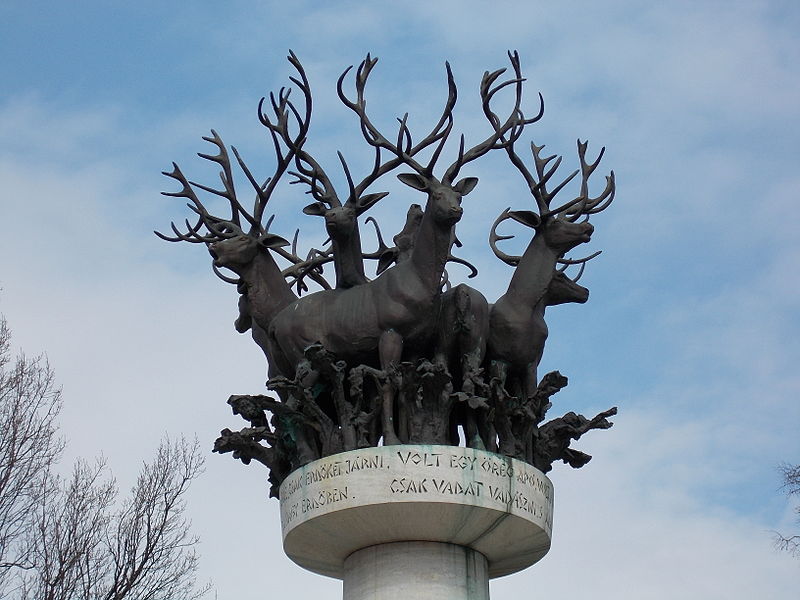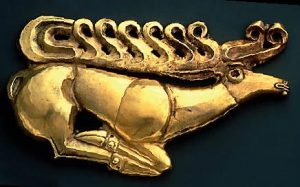Support our authors
DonateThe miraculous hind – A divine guide

Deer in Mythology
In Turkish and Hungarian mythology, the deer is one of the most important animals, along with the turul – also a divine guiding presence – and the female wolf.
The earliest known depiction of this is from the 4th century BC.

The stag represents Tengri’s – the main God’s – realm, the sky, and its antlers the many Turkic tribes. It is most often a golden colour, symbolizing the sun.
Deer – both stags and hinds – are also heavily featured in Hungarian folklore and fairy tales.
One of the most famous stories is found in Simon Kézai’s Gesta Hunnorum et Hungarorum (Deeds of the Huns and Hungarians) that tells the story of the Hun-Hungarian relations and the birth of the two tribes.
The miraculous hind
After the confusion at Babel, Menrót, the Giant (or the biblical Nimrod here) traveled to the land of Evilath, that was called Persia at the time, and there he fathered two sons by his wife, Enee (or Enéh, meaning hind). His other wifes also bore him many sons and daughters.
 The two eldest by Enee, called Hunor and Magor had their own tents.
The two eldest by Enee, called Hunor and Magor had their own tents.
One day they went hunting, and on the steppe, they happened upon a beautiful hind. The animal ran and gave chase, until it disappeared in the Meotis marshes, south of the Sea of Azov. They searched for it everywhere but they never found it again.
After this, the brothers bade farewell to their families and decided to live in the marshes of Meotis. Six years later, they came upon the wives and children of Belar’s sons, who were all without their husbands, Hunor and Magor abducted them all and took them to the marshes.
When it turned out that two of the women were the daughters of Dula, the leader or the Alans, Hunor married one, and Magor married the other. Their descendants became the Huns and the Magyars (as Hungarians call themselves).
Kézai intentions
It is entirely possible, that Simon Kézai wanted to prove our direct connection to Huns and Attila, thus creating a picture of not just a glorious past, but also telling of the fierceness of Hungarians, whom once the whole of Western Europe feared, and and called the sons of the biblical Gog and Magog through our Scythian heritage.
![]()
It is also possible that the original story Kézai referenced, spoke about Hunor as Onur and our connection to the onogur Turkic tribes Hungarians were part of. Kézai created proof of Huns and Hungarians being brothers, and by mentioning Belar’s sons, and the daughters of Dula, our connection to the Bulgarians and the Alans respectively. In his version, Ménrót’s other sons by other wives stepped in to represent the other Turkic tribes, with a looser connection, than with the Huns.
Medieval depiction of the miraculous hind from Chronicon Pictum. Source: wikipedia.orgThe miracolous hind can also be found in Chronicon Pictum, a medieval illustrated chronicle that – like Simon Kézai’s and Anonymus’s Gesta, references an old, now lost ancient gesta. This tale has obvious connections to Scythian folklore. The hind is a goddess here, a divine guide, but also a fertility symbol, because it helps finding the princesses that would give birth to all Huns and Hungarians.
The Hungarian word for mother and hind also has the same roots.
Other appearances and Christian tales
 It is a common motif in medieval chronicles that a deer shows where to build a fortress, a church or a monastery.
It is a common motif in medieval chronicles that a deer shows where to build a fortress, a church or a monastery.
In Anonymus’s Gesta Hungarorum we also find a magical stag.
In this, Böngér’s son, Bors and his knights were sent to find a place to build a castle and fortress. When he saw a deer, he gave chase. He could finally kill it upon a hilltop, when he looked around, he decided he found the perfect place. He also gave his own name to the castle, Bors.
Like with other motifs from ancient mythology and folklore, deer made it into Christian stories as well. Saint Gerard (Gellért) of Csanád, Saint Ladislaus, Saint Stephen and his son, Saint Emeric were all visited by a deer to guide them. These animal were then seen as the messenger of God; an Angel or sometimes even Christ himself.
Later the Eastern folk stories merged with the stories of Saint Eustace and Saint Hubertus, but some details still retain ancient characteristics.

In folk songs, the deer is always a stag, it has a thousand horns and on them a thousand candles, on its two kidneys two gold crosses.
In some myths the wondrous hind is golden, has a morning star on its forehead (Venus), a Moon on its belly, and the Sun between its antlers.
Béla Bartók, the famous Hungarian composer wrote a famous work Cantata Profana (The Nine Enchanted Stags) for double mixed chorus and orchestra. It is based on folk tales of the peoples of the Carpathian Basin.
Statue of the Cantata Profana by László Marton in the 12. district of Budapest.
Check available ghost tour prague, provided by Mysterium Tours
